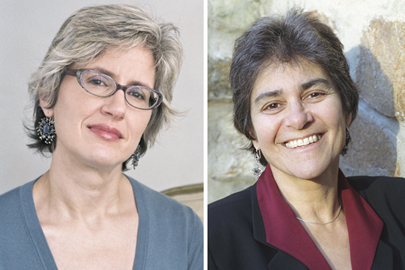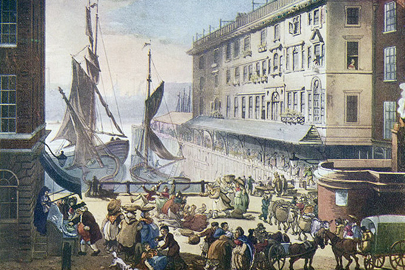Mapping culture, Plague in 18th-century London
Joint history and literature course wins award
 Photos/Mike Lovett
Photos/Mike LovettProfs. Jane Kamensky (left), Susan Lanser
A new class on 18th-century London that has students reading novels, tracking the Great Plague and following the course of history on individual maps has won the Innovative Course Design award from the American Society for Eighteenth-Century Studies for its creators.
Jane Kamensky, the Harry S. Truman Professor of American Civilization and Susan Lanser, professor of English, Women’s and Gender Studies and Comparative Literature, collaborated to bring students a class that combines history and literature for a comprehensive understanding of what it might have been like to live in London during the period. Taught in the fall of 2010, it is the first joint English-history course to be offered at Brandeis. It will be offered again during the 2013-14 academic year.
Kamensky and Lanser say they conceived the course as a laboratory for studying the period from Restoration to Regency during which London became Europe’s largest city, a cultural and commercial capital with a crucial role in forging the British Empire and the modern world. They approached the topic chronologically, concentrating on key trends and events through a combination of lectures, discussions, group projects and individual research assignments that emphasized encounters with the city’s changing geography.
 |
| Billingsgate Market (1808) |
"We both specialize in the 18th-century, with England as a point of intersection,” says Lanser. “London, already then a global nexus, formed the laboratory where our shared and distinctive interests could converge.”
They kicked off the class with historical framing about the nature of the city as a social and material entity and with a brief history of London as it emerged from its Roman and Medieval influences. Students researched decades that saw the Stuart restoration, the devastation of London by plague and fire, and the political crises that made 18th-century Britain a fervently Protestant nation with a strong parliament and an influential public sphere of conversation and print.
The course also explored London’s art, music, architecture, theater and popular culture.
Final units examined the political tumult of the 1780s and 1790s and assessed the effects of Regency-era industrialization and architectural improvement in creating a city that would grow exponentially during Victoria’s long reign. To provide understanding of the larger forces shaping 18th-century London cultural and social life, they assigned Roy Porter’s “English Society in the Eighteenth Century.” In order to keep a tight geographical consciousness throughout the course, they worked regularly with historical maps through Peter Whitfield’s catalogue of the British Museum exhibition “London: A Life in Maps,” and ordered, as a course text, a modern map of central London that students brought to every class.
This recourse to maps, they say, fostered students’ geographic imagination and allowed them to walk the textual city and read the walking city, tracing the daily travels of such figures as Pepys and Boswell, locating relationships among neighborhoods and keeping in mind the centrality of the Thames in organizing city life.
“Funding from the Mandel Center for the Humanities allowed the opportunity to expand the design itself to include fields that extended beyond our areas of expertise,” says Lanser. “For example, we were able to bring distinguished specialists in both music and architecture into our classroom.”
Through presentations at the end of the term, students taught their peers about subjects from sugar consumption to urban shopping to newspaper representations of actors, and from concepts of liberty to coffeehouse geography to Londoners’ responses to the Stamp Act.
“I learned so much about the craft of pedagogy from Sue,” says Kamensky. “New ways to think about combinations of lecture, small group work and class discussions, and rituals like closing class with a poem. Because Sue is a literature specialist, I also learned different ways of approaching texts.”
Lanser says that Kamensky’s expertise encompasses a broader range of texts — from paintings to maps — than her own typical word-bound repertoire.
“I am now better able to integrate visual materials into my courses,” says Lanser. “The course taught me how historians think, an understanding that translates from my teaching to my research.”
Categories: Humanities and Social Sciences






